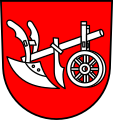Plowshare


In
The plowshare itself is often a hardened blade dressed into an integral moldboard (by the blacksmith) so making a unified combination of plowshare and moldboard, the whole being responsible for entering the cleft in the earth (made by the coulter's first cutting-through) and turning the earth over.
In well-tilled terrain the plowshare may do duty without a preceding coulter.
In modern plows both coulter and plowshare are detachable for easy replacement when worn or broken.
History

Triangular-shaped stone ploughshares are found at the sites of Chinese
In heraldry
Ploughshares are often used in heraldry.
In ancient cultures
The ancient phrase from the biblical Book of Isaiah, "to turn swords to ploughshares," is still in common use today. These ploughshares represent peaceful use of wartime capabilities. On the other hand, the Book of Joel uses the phrase in reverse, "Beat your plowshares into swords".
However, in
References
- ^ Harris (1996), 427–428.
- ^ You Archived 2011-07-06 at the Wayback Machine (1999), 1–8.
External links






